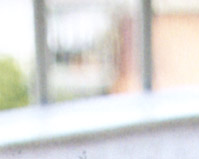Originally posted by Tippster:
Bokeh
Yes, I "googled" that.
That's a good explanation, but that guy left an important detail.
For those who didn't read it,
bokeh is a term used to describe how a lens renders the area of the picture that is out of focus. It's somewhat subjective, but generally a lens with a good bokeh will present a nice, smooth blending of the out-of-focus elements in the frame, providing good separation for the elements that are in focus. A lens with bad bokeh will produce uneven unfocused areas that bunch up in patterns that detract from the area of the frame that is in focus.
One common effect (the detail this guy didn't mention) is a "double image." In some lenses with poor bokeh, as the image goes out of focus the circles converge in such a way that instead of blending smoothly, they appear to split the image unto faint double images. I have seen this effect in some of the low-cost plastic lenses that get sold with entry-level DVCPro and DV cameras, and even in some of the cheaper glass lenses.
The best bokeh I have noticed in a video lens is in Canon's HD glass. Part of what makes HD video look so good is that Canon has for years been developing lenses with good bokeh, and it makes the focused areas of the picture look even sharper. You might do a resolution test on a Canon lens and find that it's technically really no sharper than another lens, but it will usually
look sharper because it has such a good bokeh.
Several years ago I was shooting a film with a set of newer generation Zeiss Superspeed prime lenses on an Arri SRII. Because of an equipment conflict, we had to give up our camera and borrow an Aaton that only had a big Canon zoom with it. The first thing we noticed was that that zoom looked better than the primes, not because it was sharper, but because that Canon bokeh was so beautifully even. Luckily we shot entire scenes with the Canon lens and didn't have to mix the footage within scenes, but I was still irritated that the footage didn't match exactly throughout the whole film. On the other hand, I might have been one of three or four people in the theater at the premier who noticed the difference.
Here's some bad bokeh:
I hope your lens doesn't look like that.
Here's some better bokeh:
Notice how smooth and even the background is, popping out the leaf? Actually, the leaf isn't really that sharp, but it looks good because of the nice separation.
Here's some nasty double-image bokeh:
Notice that the image is bunching up in vertical lines out to the left and right of the objects in frame. This is just sad.
Holy crap this is ugly:
I'll just leave it at that.






